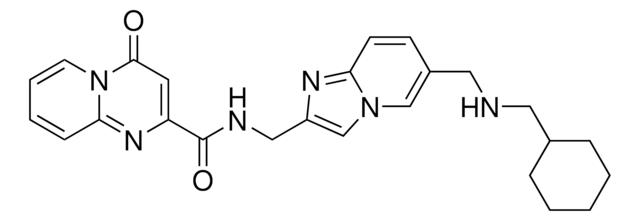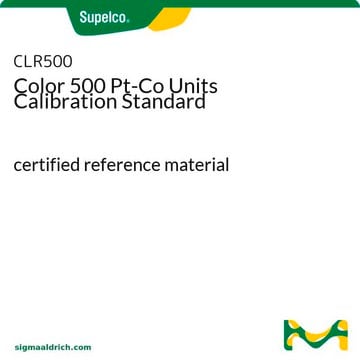SMAI-RO
Roche
Sma I
from Serratia marcescens Sb
About This Item
Produits recommandés
Source biologique
Serratia marcescens
Niveau de qualité
Forme
solution
Activité spécifique
10000 U/mL
Conditionnement
pkg of 1,000 U (10220566001 [10 U/μl])
pkg of 5,000 U (10656348001 [10 U/μl])
pkg of 5,000 U (11047639001 [40 U/μl])
Fabricant/nom de marque
Roche
Concentration
<0.1 % (w/w)
Paramètres
25 °C optimum reaction temp.
Technique(s)
electrophoresis: suitable
Couleur
colorless
pH
7.0 (39 °F)
Solubilité
water: miscible
Adéquation
suitable for molecular biology
Application(s)
life science and biopharma
Activité étrangère
Endonucleases, none detected (up to 20 U with lambda-DNA)
Endonucleases, none detected (up to 20U with pBR 322-DNA )
Conditions d'expédition
dry ice
Température de stockage
−20°C
Catégories apparentées
Description générale
Spécificité
*C °C*CGGG
Restriction site: *C °C*C↓GGG
*C °C*C↓GGG
Heat inactivation: Sma I can be heat inactivated by incubation at 65 °C for 15 minutes (up to 100 U/μg DNA).
Application
Qualité
1μg λDNA is incubated for 16 hours in 50μl SuRE/Cut Buffer A with an excess of Sma I. The number of enzyme units which do not change the enzyme-specific pattern is stated in the certificate of analysis.
Absence of exonuclease activity
Approximately 5μg [3H] labeled calf thymus DNA are incubated with 3μl Sma I for 4 hours at +37°C in a total volume of 100μl 50mM Tris-HCl, 10mM MgCl2, 1mM Dithioerythritol, pH approximately 7.5. Under these conditions, no release of radioactivity is detectable, as stated in the certificate of analysis.
Profil d'ADN
- λ: 3
- φX174: 0
- Ad2: 12
- M13mp7: 0
- pBR322: 0
- pBR328: 0
- pUC18: 1
- SV40: 0
Définition de l'unité
Stockage et stabilité
Remarque sur l'analyse
Sma I generates ends that are compatible with any blunt end.
Isoschizomers
The enzyme is an isoschizomer to Cfr9 I, PspA I, Xma I, and XmaC I.
Methylation sensitivity
Sma I is not inhibited by 5-methylcytosine at the middle of the three C residues (°) in the recognition sequence. However, the activity is inhibited by 5-methylcytosine at the other Cs (*) or 4-methylcytosine in any position within the recognition sequence (*C°C*C↓GGG).
Incubation temperature
+25°C
PFGE tested
Sma I has been tested in Pulsed-Field Gel Electrophoresis (on bacterial chromosomes). For cleavage of genomic DNA (E. coli C 600) embedded in agarose for PFGE analysis, we recommend 10 U of enzyme/μg DNA and 4 hour incubation time.
Ligation and recutting assay
Sma I fragments obtained by complete digestion of 1μg λDNA are ligated with 1U T4 DNA Ligase in a volume of 10μl by incubation for 16 hours at +25°C in 66mM Tris-HCl, 5mM MgCl2, 5mM Dithioerythritol, and 1mM ATP, pH 7.5 (at +20°C) resulting in >80% recovery of 1μg λDNA fragments.
Subsequent re-cutting with Sma I yields >80% of the typical pattern of λDNA × Sma I fragments.
The buffer in bold is recommended for optimal activity
- A: 100%
- B: 0-10%
- H: 0-10%
- L: 0-10%
- M: 0-10%
Relative activity in PCR mix (Taq DNA Polymerase buffer) is 100%. The PCR mix contained λDNA, primers, 10 mM Tris-HCl (pH 8.3, 20 °C), 50 mM KCl, 1.5 mM MgCl2, 200 μM dNTPs, 2.5 U Taq DNA polymerase. The mix was subjected to 25 amplification cycles.Activity in reaction buffer of Pwo SuperYield DNA Polymerase PCR Mix is 100%. If supplemented with GC-RICH Solution, activity remains at 100%. Pwo SuperYield DNA Polymerase PCR Mix is not available in U.S.
Autres remarques
Composants de kit seuls
- Enzyme Solution
- SuRE/Cut Buffer A 10x concentrated
Code de la classe de stockage
12 - Non Combustible Liquids
Classe de danger pour l'eau (WGK)
WGK 1
Point d'éclair (°F)
does not flash
Point d'éclair (°C)
does not flash
Certificats d'analyse (COA)
Recherchez un Certificats d'analyse (COA) en saisissant le numéro de lot du produit. Les numéros de lot figurent sur l'étiquette du produit après les mots "Lot" ou "Batch".
Déjà en possession de ce produit ?
Retrouvez la documentation relative aux produits que vous avez récemment achetés dans la Bibliothèque de documents.
Articles
The term “Restriction enzyme” originated from the studies of Enterobacteria phage λ (lambda phage) in the laboratories of Werner Arber and Matthew Meselson.
Contenu apparenté
Restriction endonucleases in prokaryotes function primarily to protect against foreign genetic material, notably bacteriophage DNA.
Notre équipe de scientifiques dispose d'une expérience dans tous les secteurs de la recherche, notamment en sciences de la vie, science des matériaux, synthèse chimique, chromatographie, analyse et dans de nombreux autres domaines..
Contacter notre Service technique







